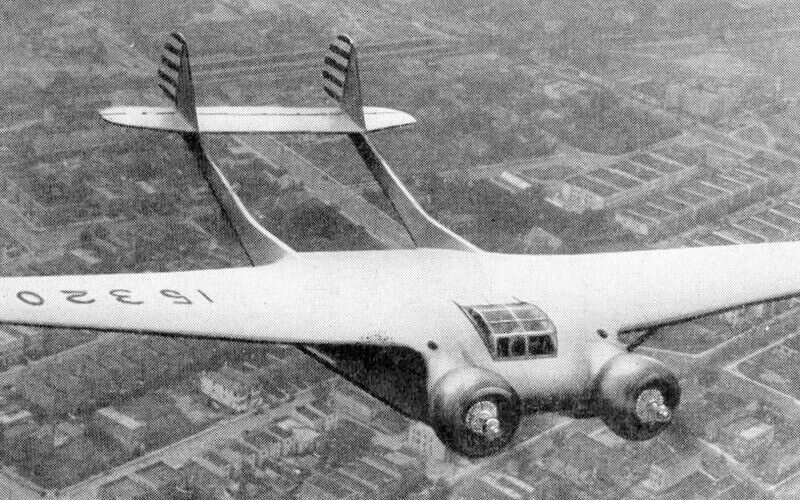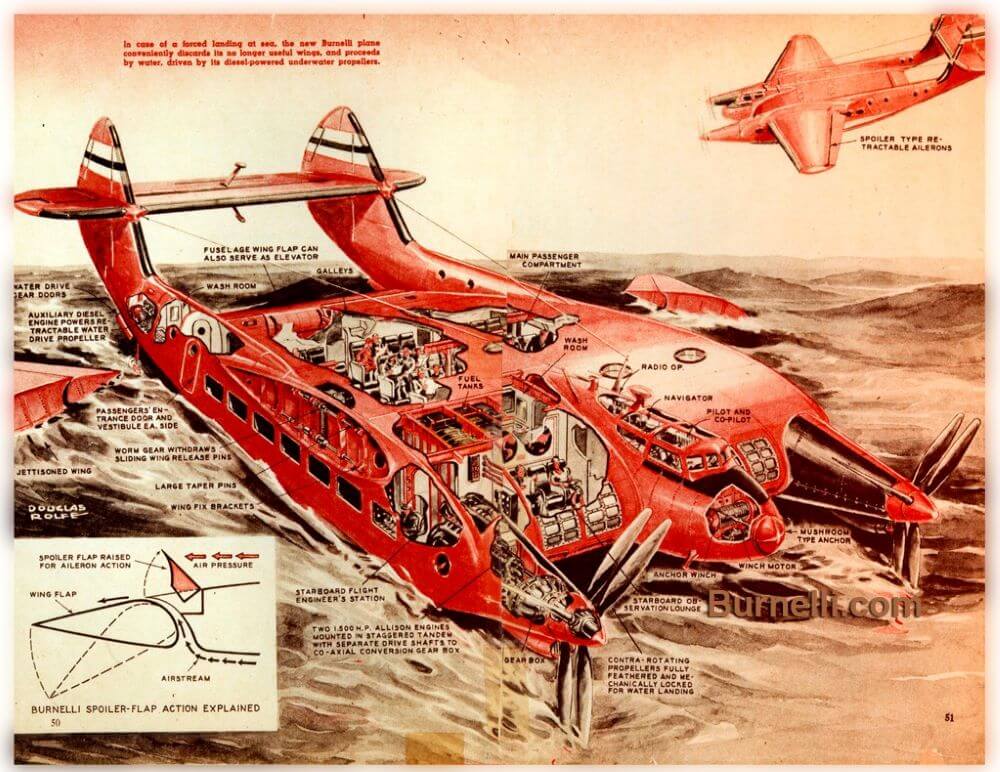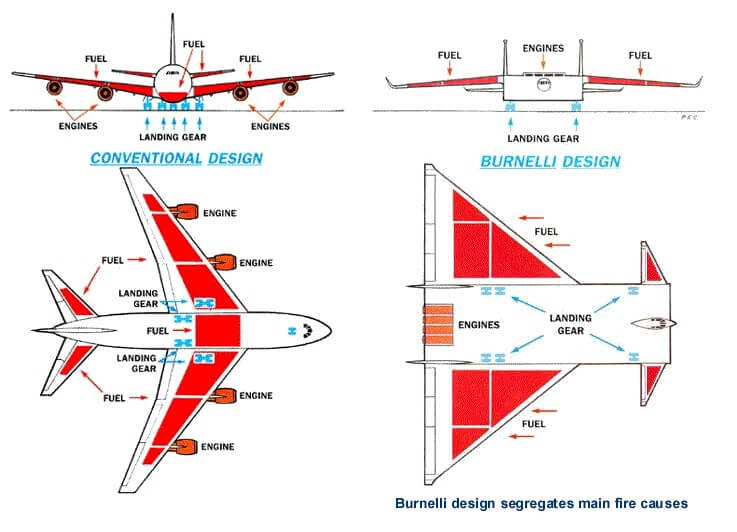Here and there on the Internet one can find claims that there is a better way to design an aircraft: by using Burnelli lifting fuselage. Is it true and has the superior technology really been suppressed?
There is a video on Youtube, most likely made in the late 80s, which may be rather shocking for anybody who has ever taken a flight onboard an airliner. If you manage to suffer through horrible video quality and eye-puncturing audio editing, you will find out that all modern aircraft are designed specifically to kill people.
According to this video, everything from the form of a fuselage to the placement of fuel tanks, seats and seatbelts is either accidentally or intentionally dangerous to passengers and will kill and maim them in an event the landing goes just slightly wrong. And, supposedly, those go wrong all the time, because aircraft are designed to have unreasonably high landing speeds and are just waiting for the smallest mistake to smash into the ground, killing everybody aboard in a horrible way.
Aircraft that use Burnelli design are different, though. They are sturdier, have reasonably located fuel tanks, low landing speeds and in general are the safest thing that could exist in aviation. Convinced yet?
Probably not, and that is a result of years and years of brainwashing by large aviation companies that try to suppress this revolutionary design.
After watching this video, it is difficult to have any other reaction than annoyance, and it is difficult to relay its contents without sarcasm. Those claims are untrue, not based on reality, and frankly, quite stupid. Nevertheless, there were – and likely are – plenty of proponents of the Burnelli design who continue to believe them. By the late 80s – the filming of the video – they consisted of several ageing men with cryptic aviation-related titles, eager to express their version of truth to the camera.
The troublemakers
The story is older though. Much older. Vincent J. Burnelli was an aircraft designer from Texas who made some moderately successful aircraft in the 20s and the 30s, before trying to pitch his designs to the military, getting into squabbles with larger aeronautical design companies, and being relegated to the pages of history.
What differentiated Burnelli designs from conventional ones was the lifting body concept: the fuselages of his aircraft had a shape that provided lift in addition to wings. The shape was boxier, wings were smaller, and engines were integrated into the fuselage or placed in close proximity.
Burnelli’s squabbles – as the video above can prove – resulted in him being excommunicated from the circle of legitimate aircraft designers and, as anybody who knew him can attest, his attitude and a manner of communicating did not mitigate that. David Noland from Air & Space Magazine managed to interview some of his followers in the late 80s, shedding light on the cult-like situation and the way both Burnelli himself and people he attracted liked to overblow their claims. The only thing they liked more than that was getting into heated arguments with both competitors and government officials, their conflicts resulting in permanent banishment.
But this does not mean that we should not examine the Burnelli design separately from the image of the designer.
The claims
The main claim of the proponents of the Burnelli design is its safety. It is said to be more survivable – “designed to crash”, not unlike, for example, cars.
But the way that result is achieved raises some questions. The first argument is that those aircraft would be sturdier, disregarding many of the weight-reduction techniques used by contemporary aircraft manufacturers.
The second argument is the placement of fuel tanks, making fuel less prone to combustion in case of a crash. By distancing tanks from engines, landing gear and passenger cabin, there would be less danger of it igniting or causing casualties even in the case of ignition.
The third argument is lower landing speed, achievable with airplanes having more wing area, therefore, more lift. Lower speed would mean smaller shock during the touchdown, and smaller probability of an accident.
There are other, smaller claims of Burnelli proponents as well: such as its ability to survive crash landing on water and even ferry passengers to land using underwater propellers, one of those Popular Science-ish ideas from the 30s.
Image: Model Airplane News, August, 1937
The aura of the period is felt even more in the latest arguments by the Burnelli crowd, expressed in an unattributed quote within one of their web-distributed manifestos:
“Research departments can easily boast that they have developed instruments and gadgets that make crashes entirely avoidable. They can add these things to the pilots’ compartment until the walls are cluttered up with them from top to bottom. They can evolve all manner of flapping, fluttering doo-dads that pop out of tails and wings and accomplish some purpose or other.” (source: Aircrash.org)
The problems
It is clear that the core claims make sense: an aircraft of Burnelli design could be more survivable by having more structural rigidity, differently placed fuel tanks, more wing area for lower landing speeds, and even special gear to swim after landings on water.
But so could any other kind of aircraft. Additional structural weight would make any airplane sturdier. It is possible to remove fuel tanks from the fuselage and relocate engines, say, to the tail of the aircraft. It is possible to give more wing area to any airplane: a regular airliner, theoretically, could have significantly lower landing speed.
Those steps are not undertaken because they would impact aircraft performance by making it heavier, slower, and reducing its range.
Image: Aircrash.org
The illustration above claims that the Boeing 747-like airplane of Burnelli design would segregate the main causes of a fire by placing fuel tanks in wings. But just a glance is enough to notice that those wings would have to be incredibly large to fit an equivalent of fuel that a wide-body airliner has to carry, resulting either in more drag or in a very limited range.
The drag is another common sense argument against the Burnelli design. Wide and boxy fuselages would generate a lot of it, especially at near-sonic speeds. That would result in more fuel burn, or less speed, or both. Add to that the additional structural weight crash-proof airplane would have to have, and you have a lot of dead weight. Not even mentioning the water-landing variant from the 30s.
The contemporary (or at least pre-COVID-19) boom of air travel was possible thanks to new efficient airplanes that had low operating costs, resulting in cheap tickets. It would be very hard to make Burnelli-type aircraft profitable, even if they would be safer.
And in the end, given the ever-increasing aviation safety and ever-decreasing amount of incidents, even despite the sharp increase in air travel, the alarmist tone of Burnelli proponents seems as outdated as their complaints that modern airplanes have too many “flapping, fluttering doo-dads”.
The bigger picture
There are several other things Burnelli conspiracy theory is failing to mention. One of them is that, in addition to the fact that the benefits of his design are not Burnelli-exclusive, is that the design is not particularly unique.
It is basically a cross between a conventional design and a flying wing design, and has strengths and weaknesses of both of them. Lifting body fuselages are not that rare of a feature, especially in military aviation (many fighter jets have a fuselage that generates at least some lift), and do not have some kind of inherent exceptional safety.
People who claim that the superior Burnelli design was suppressed by Boeing and co. demonstrate another flawed argument, featured in many contemporary conspiracy theories. Basically, they forget that the world outside the United States exists.
There were many talented designers in Europe and elsewhere who experimented – and continue to experiment – with similar designs. Amongst them were Alexandr Putilov and Konstantin Kalinin, who worked on flying wing designs in the 30s Soviet Union, creating several airliner and bomber proposals very similar to Burnelli design in both concept and appearance. None of them went beyond the stage of initial testing.
Another niche full of Burnelli-like designs are gliders: a type of aircraft where there often is a need to maximize the amount of lift, and in the case of transport gliders – increase the internal volume. Some lifting body gliders, such as General Airborne Transport XCG-16, were built in the U.S., not without Burnelli’s influence. At the same time, a whole avalanche of them appeared in other countries: Ju322 Mammut project in Germany, Maeda KU-6 in Japan, Kharkiv KhAI-3 in the Soviet Union, amongst many others. In all these cases the design never survived past the 30s.
In all cases except one. In 2020, a project from Britain gained some media attention: ULTRA, a cargo drone built by British company Windracers in conjunction with a research team from the University of Southampton, helped to carry COVID-19 supplies to the Isle of Wight. Wide fuselage, two engines, lifting body – the drone has all the hallmarks of Burnelli’s design.
If American aircraft manufacturers really conspired to eradicate that design from the face of the Earth, they did a rather poor job.



